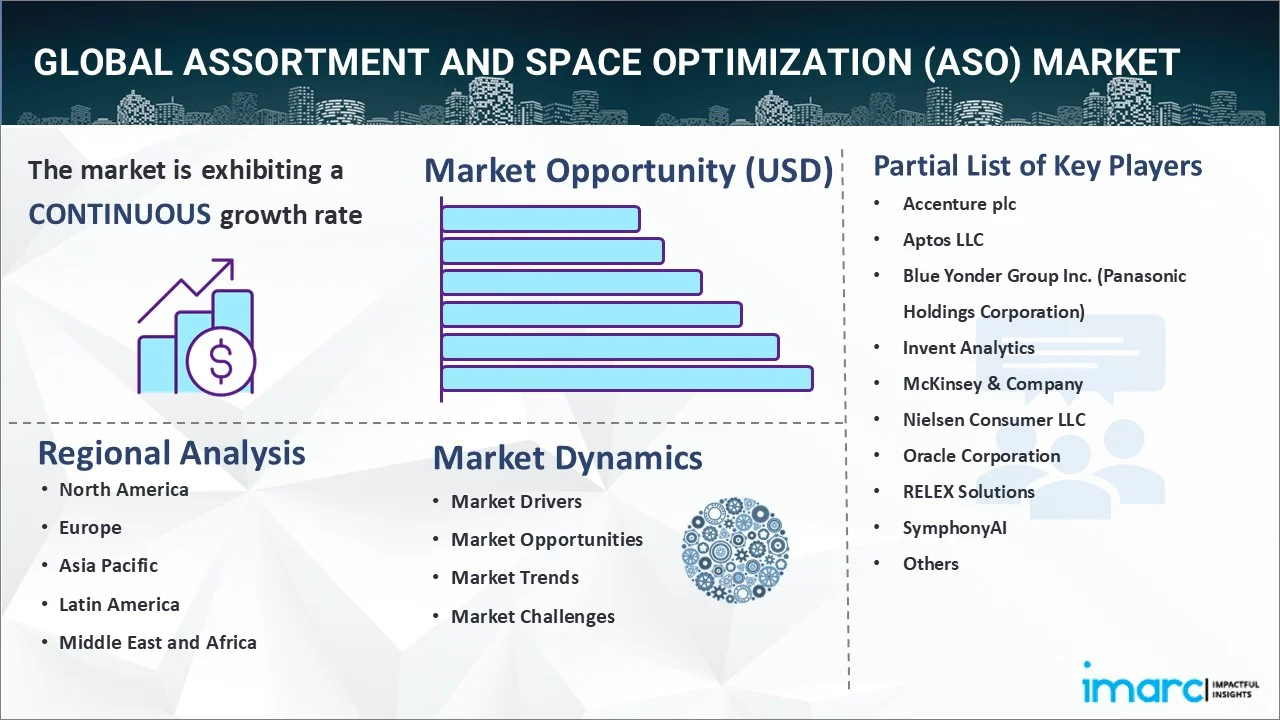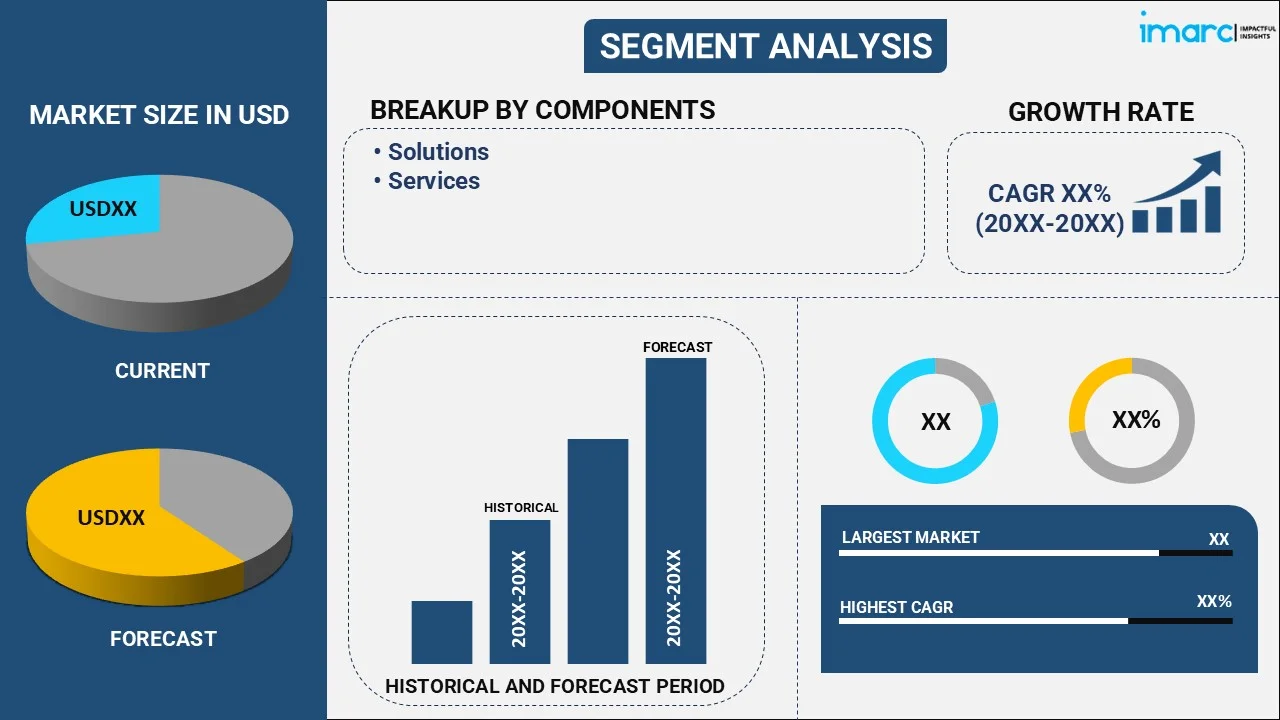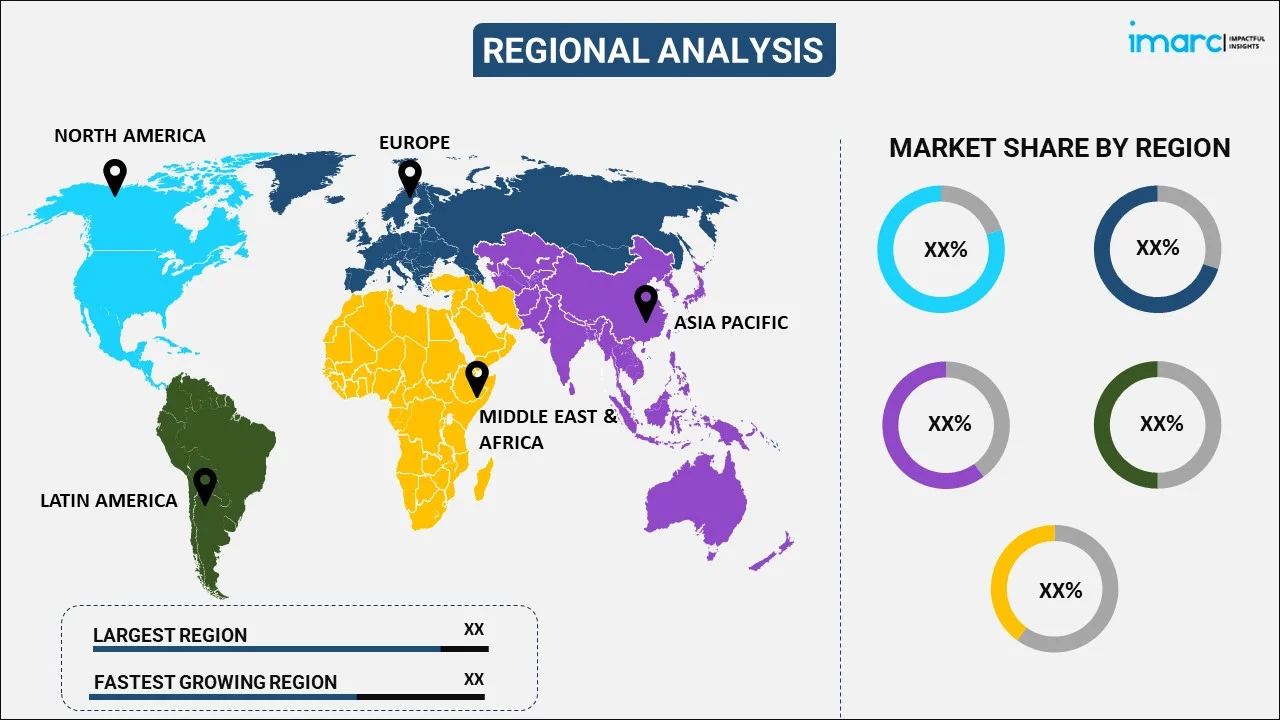
Assortment and Space Optimization (ASO) Market Report by Component (Solutions, Services), Deployment Mode (On-premises, Cloud-based), Enterprise Size (Large Enterprises, Small and Medium-sized Enterprises), and Region 2025-2033
Global Assortment and Space Optimization (ASO) Market:
The global assortment and space optimization (ASO) market size reached USD 2.1 Billion in 2024. Looking forward, IMARC Group expects the market to reach USD 5.1 Billion by 2033, exhibiting a growth rate (CAGR) of 10.42% during 2025-2033. The proliferation of stock-keeping units (SKUs), along with the development of cloud-based ASO, is bolstering the market.
|
Report Attribute
|
Key Statistics
|
|---|---|
|
Base Year
|
2024 |
|
Forecast Years
|
2025-2033
|
|
Historical Years
|
2019-2024
|
| Market Size in 2024 | USD 2.1 Billion |
| Market Forecast in 2033 | USD 5.1 Billion |
| Market Growth Rate 2025-2033 | 10.42% |
Assortment and Space Optimization (ASO) Market Analysis:
- Major Market Drivers: The growing number of retailers that are adopting a demand-driven and consumer-centric assortment optimization strategy that improves profit margin, provides a better return on investment (ROI), minimizes overall costs, augments retailer’s confidence, etc., is one of the key factors bolstering the market.
- Key Market Trends: The rising trend of incorporating machine learning (ML) and artificial intelligence (AI)-based algorithms to match store’s product selection with consumer preference, prevent stockouts, develop targeted assortments, reduce markdowns, help users in better decision-making, etc., is acting as another significant growth-inducing factor.
- Geographical Trends: North America exhibits a clear dominance in the market, owing to the increasing focus among key players on offering better store coverage, macro-level space planning, enhancing product visibility, etc.
- Competitive Landscape: According to the assortment and space optimization (ASO) market overview, some of the prominent companies include Accenture plc, Aptos LLC, Blue Yonder Group Inc. (Panasonic Holdings Corporation), Invent Analytics, McKinsey & Company, Nielsen Consumer LLC, Oracle Corporation, RELEX Solutions, SymphonyAI, and TATA Consultancy Services Limited, among many others.
- Challenges and Opportunities: Maintaining and implementing ASO solutions require significant IT resources and expertise, which may be limited for some retailers, particularly smaller or mid-sized organizations. This can hamper the overall market. However, the launch of cloud-based ASO that streamlines workflow, offers real-time data with space-aware analytics, and allows manufacturers to access performance data remotely, is expected to drive the market over the forecasted period.

Assortment and Space Optimization (ASO) Market Trends:
Adoption of Data-Driven Strategies
Retailers are adopting big data to gain deep insights into customer preferences, behavior, and purchasing patterns. This information is critical in optimizing inventory levels, creating personalized marketing messages, improving the overall customer experience, etc. Retailers who leverage data analytics saw a 20% increase in customer satisfaction. Moreover, by adopting large volumes of data from several sources, such as inventory, customer behavior, sales, market trends, etc., ASO solutions enable retailers to gain deep visibility into their operations and performance. This, in turn, is propelling the assortment and space optimization (ASO) market growth. For example, in June 2023, SymphonyAI Retail CPG, a SymphonyAI division, released global shopper research that revealed how customer-centric and data-based product assortments could grow overall sales of retailers and customer loyalty, even during unfavorable economic conditions. The study found that stores that were using AI-powered assortments customized for local shoppers generated nearly 1-2% more in annual incremental sales than those without. Besides this, through advanced analytics, key industry players can identify patterns, trends, and correlations in the data, uncovering valuable insights that inform strategic decisions regarding product placement, assortment, and space allocation. For instance, in February 2023, Google Cloud announced the launch of initiatives with Accenture to help retailers to modernize their businesses and benefit from cloud technology, including updates to Accenture’s widely adopted ai. RETAIL platform that deeply integrates Google Cloud’s leading capabilities in AI, data analytics, and product discovery. The two companies also committed to go-to-market initiatives to offer retailers the resources and technology needed to transform store operations, thereby expanding on joint customer successes. Besides this, the increasing inclination towards a consumer-centric assortment optimization strategy will continue to augment the assortment and space optimization (ASO) market demand over the forecasted period. For example, in March 2024, Dunnhumby, one of the global leaders in customer data science, and Placer.ai, one of the prominent players in location analytics, partnered to empower retailers in the U.S. to unlock online as well as offline customer insights and create unique customer propositions. By behavioral science, combining location data, and Dunnhumby expertise in retail consulting, the partnership aimed to give CPG companies an edge in highly competitive environments.
Need for Space Optimization
The growing space restrictions are inflating the need for ASO solution, which plays a crucial role in maximizing efficiency. Besides this, by leveraging optimization algorithms and advanced analytics, they enable retailers to analyze customer behavior, sales data, product attributes, etc., to determine the most effective allocation of space within their stores. For example, in June 2021, MerchLogix, one of the leading providers of space planning and merchandise operations software, launched a Planogram to extend its space planning solution. This solution is based on cloud technology and encourages a collaborative approach to connecting stores, space planning, and merchants. Apart from this, ASO solutions enable retailers to create flexible and dynamic space plans that can adapt in real time to changes in seasonal variations, market trends, and promotional activities, thereby ensuring optimal use of retail space to maximize return on investment and drive sales. This is creating a positive assortment and space optimization (ASO) market outlook. For instance, in March 2024, ROSSMANN Group, one of the leading drugstore retailers in Germany, selected the SymphonyAI store and space planning to drive automation, scale, and provide quality shopper experience in Spain. In addition to this, in April 2024, retail space planning specialist CADS used StoreSpace software to transform store planning process for Mexican retailer Grupo Merza.
Increasing Integration of Retail Technologies
Assortment and space optimization solutions are widely being integrated with other retail technologies, such as inventory management software, point-of-sale systems, customer relationship management (CRM) platforms, etc., to create seamless end-to-end retail operations. Moreover, these platforms enable retailers to leverage data from various sources to gain deeper insights into their business and enhance decision-making across the entire retail value chain, which is one of the assortment and space optimization (ASO) market recent opportunities. For example, in October 2023, Introhive, one of the leading providers of Client Intelligence solutions, announced the launch of its new platform that empowers professional services firms to strengthen, uncover, and harness their known network of relationships. Besides this, the inflating popularity of customer relationship management (CRM) platforms that allow industry players to maintain and build relationships with customers by capturing and analyzing data to improve customer satisfaction and personalize marketing efforts is also strengthening the market. For instance, in June 2023, global diversified manufacturer Milliken & Company successfully introduced an enterprise customer relationship management (CRM) solution, Spark, built with the help of Salesforce partner eVerge.
Assortment and Space Optimization (ASO) Market Segmentation:
IMARC Group provides an analysis of the key trends in each segment of the market, along with the assortment and space optimization (ASO) market forecast at the global, regional, and country levels for 2025-2033. Our report has categorized the market based on the component, deployment mode, and enterprise size.
Breakup by Component:

- Solutions
- Services
The report has provided a detailed breakup and analysis of the market based on the component. This includes solutions and services.
Assortment and space optimization (ASO) solutions usually comprise software platforms and tools designed to optimize space allocation, product assortments, and retail layout. Additionally, these solutions generally include machine learning algorithms, advanced analytics, and visualization tools to analyze customer behavior, sales data, and market trends, enabling retailers to make informed decisions. For instance, in January 2024, Sam’s Club, a membership retail club under Walmart, deployed AI and computer vision technology across more than 120 locations in the U.S. Similarly, in January 2024, Walmart developed a new GenAI-powered search tool that is now available to iOS users and enables customers to search by specific use cases, thereby generating relevant, cross-category results. ASO services, on the other hand, encompass a range of implementation, consulting, and support offerings provided by third-party providers and vendors to help retailers deploy and maximize the effectiveness of ASO solutions. This, in turn, is increasing the assortment and space optimization (ASO) market revenue. For example, in March 2024, RadASO, a top-tier mobile app marketing agency renowned for its innovative approach in UA and ASO, collaborated with Asolytics, a leading app growth assistance team providing SaaS solutions for ASO, to offer a comprehensive range of ASO services.
Breakup by Deployment Mode:
- On-premises
- Cloud-based
Cloud-based accounted for the largest market share
The report has provided a detailed breakup and analysis of the market based on the deployment mode. This includes on-premises and cloud-based. According to the report, cloud-based represented the largest market segmentation.
The growth in this segmentation is driven by the scalability, flexibility, and accessibility offered by cloud-based ASO solutions. Apart from this, by leveraging cloud infrastructures, retailers can access ASO software and data analytics tools remotely via the internet, thereby eliminating the requirement for on-premises hardware and infrastructure investments. Moreover, various strategic collaborations among key players are elevating the assortment and space optimization (ASO) market’s recent price in this segmentation. For example, in December 2023, Glory Global Solutions (International) Ltd, a wholly-owned subsidiary of GLORY Ltd., acquired the issued share capital of Flooid, one of the leaders in cloud-based unified commerce software across the retail industry, from Inflexion Private Equity Partners.
Breakup by Enterprise Size:
- Large Enterprises
- Small and Medium-sized Enterprises
Large enterprises accounted for the largest assortment and space optimization (ASO) market share
The report has provided a detailed breakup and analysis of the market based on the enterprise size. This includes large enterprises and small and medium-sized enterprises. According to the report, large enterprises represented the largest market segmentation.
Complex operations, extensive resources, and strategic focus on optimizing retail performance are driving the growth in this segmentation. Additionally, large enterprises have the organizational capabilities and financial resources to integrate and implement ASO solutions at scale, leveraging their size and market influence to drive innovation and shape industry trends. For example, Erply provides a software infrastructure for large retail enterprises. Moreover, Erply’s powerful API enables these enterprises to run and design advanced retail software solutions like automatic stock replenishment systems, automated warehouses and delivery services, and management of large-scale production.
Breakup by Region:

- North America
- United States
- Canada
- Europe
- Germany
- France
- United Kingdom
- Italy
- Spain
- Others
- Asia Pacific
- China
- Japan
- India
- South Korea
- Australia
- Indonesia
- Others
- Latin America
- Brazil
- Mexico
- Others
- Middle East and Africa
North America exhibits a clear dominance in the market
The market research report has also provided a comprehensive analysis of all the major regional markets, which include North America (the United States and Canada); Europe (Germany, France, the United Kingdom, Italy, Spain, and others); Asia Pacific (China, Japan, India, South Korea, Australia, Indonesia, and others); Latin America (Brazil, Mexico, and others); and the Middle East and Africa. According to the report, North America accounted for the largest market share.
The inflating demand for consumer-centric and demand-driven strategies is propelling the regional market. For instance, Worldline, one of the local payment experts, offers online payments and bank-to-bank payment methods across North America to streamline customer journeys. Moreover, according to the assortment and space optimization (ASO) market statistics, extensive investments in R&D activities to develop innovative ASO solutions are acting as significant growth-inducing factors. For example, in October 2023, Canac became the first retailer in North America to partner with ARISTID Retail Technology, a global leader in promotional communications technology. Similarly, in March 2024, GK Software, one of the global leaders in comprehensive retail applications for real-time omnichannel business systems, announced that Follett Higher Education, North America’s leading provider of collegiate retail and course materials, selected GK as its new cloud-based point-of-sale provider.
Competitive Landscape:
The market research report has provided a comprehensive analysis of the competitive landscape. Detailed profiles of all major assortment and space optimization (ASO) market companies have also been provided. Some of the key players in the market include:
- Accenture plc
- Aptos LLC
- Blue Yonder Group Inc. (Panasonic Holdings Corporation)
- Invent Analytics
- McKinsey & Company
- Nielsen Consumer LLC
- Oracle Corporation
- RELEX Solutions
- SymphonyAI
- TATA Consultancy Services Limited
(Please note that this is only a partial list of the key players, and the complete list is provided in the report.)
Assortment and Space Optimization (ASO) Market Recent Developments:
- February 2024: Brevo, one of the leading providers of customer relationship management (CRM) solutions, announced the introduction of the Brevo Customer Data Platform (CDP) and mobile push following the acquisitions of Octolis and WonderPush, demonstrating its capacity to quickly integrate new stacks within its solution.
- February 2024: Zoho Corporation, the parent company of leading technology brands Zoho.com, ManageEngine, TrainerCentral, and Qntrl, launched a new brand in India called Zakya, which is a POS solution for retail stores. This solution aids the stores in streamlining their day-to-day operations and monitoring them from one place.
- January 2024: Lenovo featured AI-powered and end-to-end retail solutions at the Big Retail Show in New York City to support safer, smarter, and more secure experiences for retailers and shoppers across any category.
Assortment and Space Optimization (ASO) Market Report Scope:
| Report Features | Details |
|---|---|
| Base Year of the Analysis | 2024 |
| Historical Period | 2019-2024 |
| Forecast Period | 2025-2033 |
| Units | Billion USD |
| Scope of the Report | Exploration of Historical and Forecast Trends, Industry Catalysts and Challenges, Segment-Wise Historical and Predictive Market Assessment:
|
| Components Covered | Solutions, Services |
| Deployment Modes Covered | On-premises, Cloud-based |
| Enterprise Sizes Covered | Large Enterprises, Small and Medium-sized Enterprises |
| Regions Covered | Asia Pacific, Europe, North America, Latin America, Middle East and Africa |
| Countries Covered | United States, Canada, Germany, France, United Kingdom, Italy, Spain, China, Japan, India, South Korea, Australia, Indonesia, Brazil, Mexico |
| Companies Covered | Accenture plc, Aptos LLC, Blue Yonder Group Inc. (Panasonic Holdings Corporation), Invent Analytics, McKinsey & Company, Nielsen Consumer LLC, Oracle Corporation, RELEX Solutions, SymphonyAI, TATA Consultancy Services Limited, etc. |
| Customization Scope | 10% Free Customization |
| Post-Sale Analyst Support | 10-12 Weeks |
| Delivery Format | PDF and Excel through Email (We can also provide the editable version of the report in PPT/Word format on special request) |
Key Questions Answered in This Report:
- How has the global assortment and space optimization (ASO) market performed so far, and how will it perform in the coming years?
- What are the drivers, restraints, and opportunities in the global assortment and space optimization (ASO) market?
- What is the impact of each driver, restraint, and opportunity on the global assortment and space optimization (ASO) market?
- What are the key regional markets?
- Which countries represent the most attractive assortment and space optimization (ASO) market?
- What is the breakup of the market based on the component?
- Which is the most attractive component in the assortment and space optimization (ASO) market?
- What is the breakup of the market based on the deployment mode?
- Which is the most attractive deployment mode in the assortment and space optimization (ASO) market?
- What is the breakup of the market based on enterprise size?
- Which is the most attractive enterprise size in the assortment and space optimization (ASO) market?
- What is the competitive structure of the global assortment and space optimization (ASO) market?
- Who are the key players/companies in the global assortment and space optimization (ASO) market?
Key Benefits for Stakeholders:
- IMARC’s report offers a comprehensive quantitative analysis of various market segments, historical and current market trends, market forecasts, and dynamics of the assortment and space optimization (ASO) market from 2019-2033.
- The research study provides the latest information on the market drivers, challenges, and opportunities in the global assortment and space optimization (ASO) market.
- The study maps the leading, as well as the fastest-growing, regional markets. It further enables stakeholders to identify the key country-level markets within each region.
- Porter's five forces analysis assist stakeholders in assessing the impact of new entrants, competitive rivalry, supplier power, buyer power, and the threat of substitution. It helps stakeholders to analyze the level of competition within the assortment and space optimization (ASO) industry and its attractiveness.
- Competitive landscape allows stakeholders to understand their competitive environment and provides an insight into the current positions of key players in the market.
Need more help?
- Speak to our experienced analysts for insights on the current market scenarios.
- Include additional segments and countries to customize the report as per your requirement.
- Gain an unparalleled competitive advantage in your domain by understanding how to utilize the report and positively impacting your operations and revenue.
- For further assistance, please connect with our analysts.
 Request Customization
Request Customization
 Speak to an Analyst
Speak to an Analyst
 Request Brochure
Request Brochure
 Inquire Before Buying
Inquire Before Buying




.webp)




.webp)












